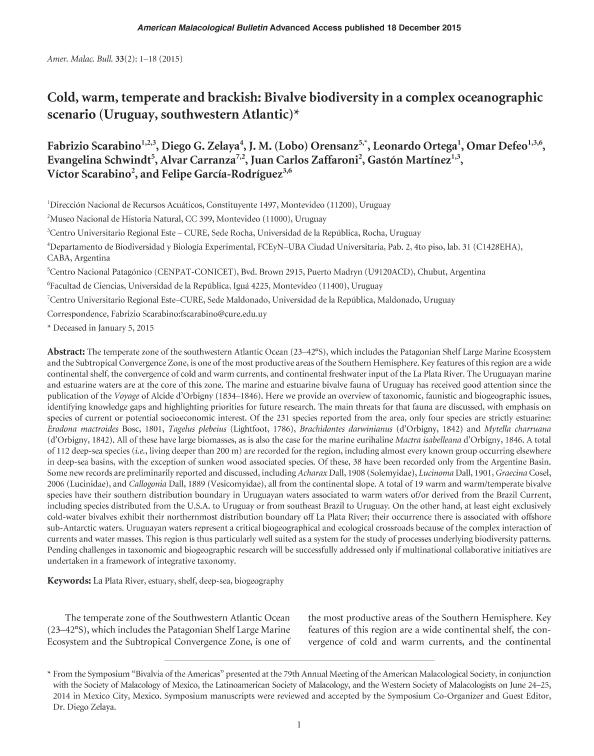Mostrar el registro sencillo del ítem
dc.contributor.author
Scarabino, Fabrizio
dc.contributor.author
Zelaya, Diego Gabriel

dc.contributor.author
Orensanz, Jose Maria

dc.contributor.author
Ortega, Leonardo
dc.contributor.author
Defeo Gorospe, Omar

dc.contributor.author
Schwindt, Evangelina

dc.contributor.author
Carranza, Alvar
dc.contributor.author
Zaffaroni, Juan Carlos
dc.contributor.author
Martínez, Gastón
dc.contributor.author
Scarabino, Victor
dc.contributor.author
Garcia Rodriguez, Felipe

dc.date.available
2018-02-26T19:32:38Z
dc.date.issued
2015-05
dc.identifier.citation
Scarabino, Fabrizio; Zelaya, Diego Gabriel; Orensanz, Jose Maria; Ortega, Leonardo; Defeo Gorospe, Omar; et al.; Cold, warm, temperate and brackish: Bivalve biodiversity in a complex oceanographic scenario (Uruguay, southwestern Atlantic); American Malacological Society; American Malacological Bulletin; 33; 2; 5-2015; 1-18
dc.identifier.issn
0740-2783
dc.identifier.uri
http://hdl.handle.net/11336/37149
dc.description.abstract
The temperate zone of the southwestern Atlantic Ocean (23-42°S), which includes the Patagonian Shelf Large Marine Ecosystem and the Subtropical Convergence Zone, is one of the most productive areas of the Southern Hemisphere. Key features of this region are a wide continental shelf, the convergence of cold and warm currents, and continental freshwater input of the La Plata River. The Uruguayan marine and estuarine waters are at the core of this zone. The marine and estuarine bivalve fauna of Uruguay has received good attention since the publication of the Voyage of Alcide d'Orbigny (1834-1846). Here we provide an overview of taxonomic, faunistic and biogeographic issues, identifying knowledge gaps and highlighting priorities for future research. The main threats for that fauna are discussed, with emphasis on species of current or potential socioeconomic interest. Of the 231 species reported from the area, only four species are strictly estuarine: Erodona mactroides Bosc, 1801, Tagelus plebeius (Lightfoot, 1786), Brachidontes darwinianus (d'Orbigny, 1842) and Mytella charruana (d'Orbigny, 1842). All of these have large biomasses, as is also the case for the marine eurihaline Mactra isabelleana d'Orbigny, 1846. A total of 112 deep-sea species (i.e., living deeper than 200 m) are recorded for the region, including almost every known group occurring elsewhere in deep-sea basins, with the exception of sunken wood associated species. Of these, 38 have been recorded only from the Argentine Basin. Some new records are preliminarily reported and discussed, including Acharax Dall, 1908 (Solemyidae), Lucinoma Dall, 1901, Graecina Cosel, 2006 (Lucinidae), and Callogonia Dall, 1889 (Vesicomyidae), all from the continental slope. A total of 19 warm and warm/temperate bivalve species have their southern distribution boundary in Uruguayan waters associated to warm waters of/or derived from the Brazil Current, including species distributed from the U.S.A. to Uruguay or from southeast Brazil to Uruguay. On the other hand, at least eight exclusively cold-water bivalves exhibit their northernmost distribution boundary off La Plata River; their occurrence there is associated with offshore sub-Antarctic waters. Uruguayan waters represent a critical biogeographical and ecological crossroads because of the complex interaction of currents and water masses. This region is thus particularly well suited as a system for the study of processes underlying biodiversity patterns. Pending challenges in taxonomic and biogeographic research will be successfully addressed only if multinational collaborative initiatives are undertaken in a framework of integrative taxonomy.
dc.format
application/pdf
dc.language.iso
eng
dc.publisher
American Malacological Society

dc.rights
info:eu-repo/semantics/openAccess
dc.rights.uri
https://creativecommons.org/licenses/by-nc-sa/2.5/ar/
dc.subject
Biogeography
dc.subject
Deep-Sea
dc.subject
Estuary
dc.subject
La Plata River
dc.subject
Shelf
dc.subject.classification
Otras Ciencias Biológicas

dc.subject.classification
Ciencias Biológicas

dc.subject.classification
CIENCIAS NATURALES Y EXACTAS

dc.title
Cold, warm, temperate and brackish: Bivalve biodiversity in a complex oceanographic scenario (Uruguay, southwestern Atlantic)
dc.type
info:eu-repo/semantics/article
dc.type
info:ar-repo/semantics/artículo
dc.type
info:eu-repo/semantics/publishedVersion
dc.date.updated
2018-02-22T14:28:12Z
dc.identifier.eissn
2162-2698
dc.journal.volume
33
dc.journal.number
2
dc.journal.pagination
1-18
dc.journal.pais
Estados Unidos

dc.description.fil
Fil: Scarabino, Fabrizio. Dirección Nacional de Recursos Acuáticos; Uruguay. Museo Nacional de Historia Natural; Uruguay
dc.description.fil
Fil: Zelaya, Diego Gabriel. Universidad de Buenos Aires. Facultad de Ciencias Exactas y Naturales. Departamento de Biodiversidad y Biología Experimental; Argentina. Consejo Nacional de Investigaciones Científicas y Técnicas; Argentina
dc.description.fil
Fil: Orensanz, Jose Maria. Consejo Nacional de Investigaciones Científicas y Técnicas. Centro Nacional Patagónico; Argentina
dc.description.fil
Fil: Ortega, Leonardo. Dirección Nacional de Recursos Acuáticos; Uruguay
dc.description.fil
Fil: Defeo Gorospe, Omar. Universidad de la República; Uruguay
dc.description.fil
Fil: Schwindt, Evangelina. Consejo Nacional de Investigaciones Científicas y Técnicas. Centro Nacional Patagónico; Argentina
dc.description.fil
Fil: Carranza, Alvar. Centro Universitario Regional Este, Universidad de la República; Uruguay. Museo Nacional de Historia Natural; Uruguay
dc.description.fil
Fil: Zaffaroni, Juan Carlos. Museo Nacional de Historia Natural; Uruguay
dc.description.fil
Fil: Martínez, Gastón. Dirección Nacional de Recursos Acuáticos; Uruguay. Centro Universitario Regional Este, Universidad de la República; Uruguay. Consejo Nacional de Investigaciones Científicas y Técnicas; Argentina
dc.description.fil
Fil: Scarabino, Victor. Museo Nacional de Historia Natural; Uruguay
dc.description.fil
Fil: Garcia Rodriguez, Felipe. Centro Universitario Regional Este, Universidad de la República; Uruguay. Facultad de Ciencias, Universidad de la República; Uruguay
dc.journal.title
American Malacological Bulletin

dc.relation.alternativeid
info:eu-repo/semantics/altIdentifier/doi/http://dx.doi.org/10.4003/006.033.0219
dc.relation.alternativeid
info:eu-repo/semantics/altIdentifier/url/http://www.bioone.org/doi/10.4003/006.033.0219
Archivos asociados
